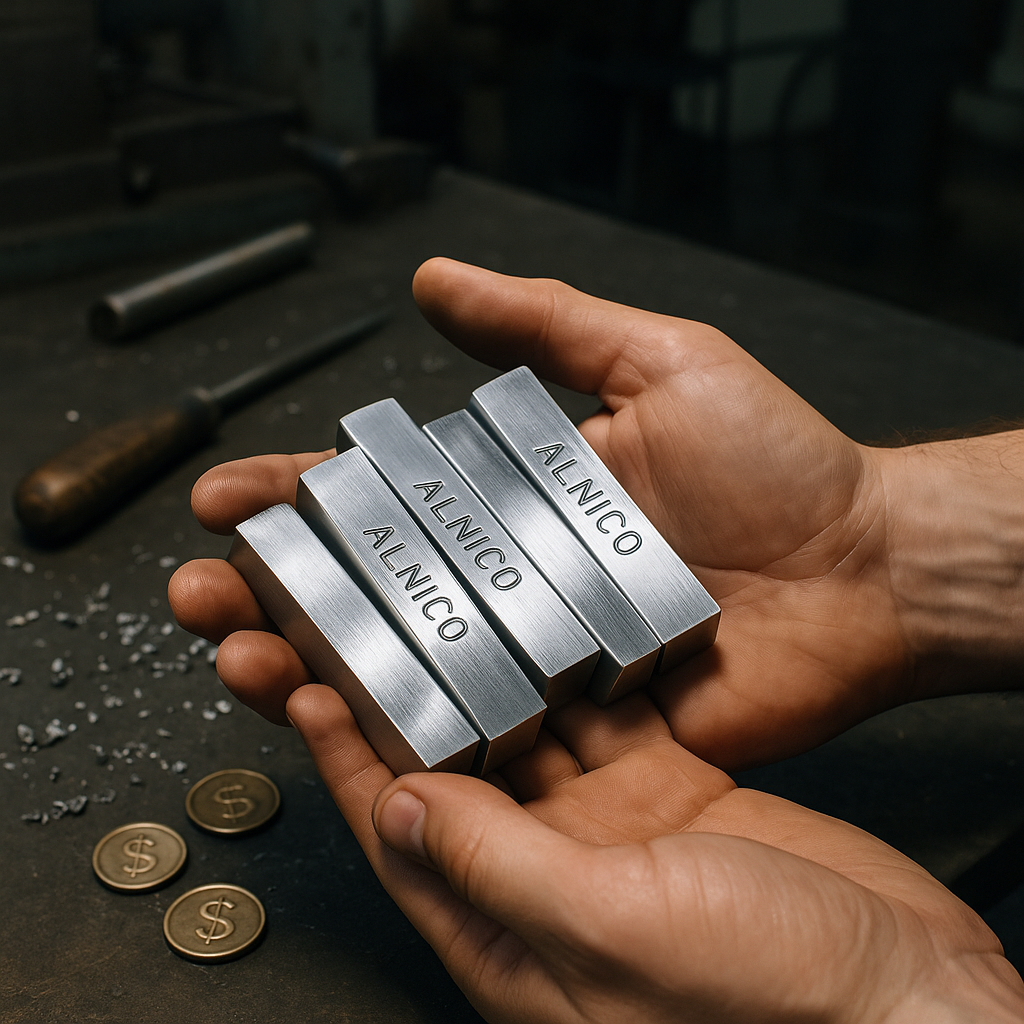5901 Botham Jean Blvd, Dallas, TX 75215
From Scrap to Strategic Asset: A Guide to the Alnico Magnet Recycling Process
November 4, 2025Hidden within every discarded Alnico magnet lies valuable metals worth recovering. These permanent magnets contain cobalt and nickel, two strategically significant rare metals with high market value and increasingly tight global supply chains. The metals in these magnets represent significant economic value that is often discarded.
Environmental concerns make Alnico magnet recycling crucial. When these magnets end up in landfills, their metal components can leach into soil and groundwater. Cobalt and nickel contamination causes long-term ecological damage. Scientific recycling processes avert this hazard while recovering materials otherwise requiring energy-intensive mining operations.
The economic case for recycling is equally compelling. Standardized recycling programs can reduce raw material costs by 30% to 50% compared to buying virgin metals. This cost reduction supports circular economy principles and demonstrates corporate social responsibility. As global cobalt supplies tighten and prices remain high, recovering these metals from waste becomes not only environmentally responsible but also financially strategic for sustainable manufacturing.
Key Stages in the Alnico Magnet Recycling Process?

The Alnico magnet recycling process is a well-established technological approach that involves precise coordination across several processing stages. This systematic procedure transforms end-of-life magnets containing aluminum, nickel, and cobalt into recoverable raw materials while maintaining high recovery rates when proper protocols are followed throughout each phase.
Pretreatment Stage
Pretreatment begins with preliminary classification to separate Alnico magnets from other magnetic materials. Workers remove protective shells and plastic coatings that often surround industrial magnets. This initial cleaning prevents contamination during later processing steps.
The classified magnets undergo crushing using specialized equipment designed for magnetic materials. The crushing equipment converts whole magnets into fine particles with controlled size distribution, facilitating more efficient separation in subsequent processing stages.
Quality control during pretreatment directly impacts the effectiveness of downstream processes. Contaminated magnets require additional cleaning steps that increase processing costs. Facilities must balance throughput speed with contamination removal to optimize operational efficiency.
Physical Sorting Stage
Physical sorting employs magnetic separation technology to isolate ferrous materials from non-magnetic components. Magnetic separation systems use powerful electromagnets to attract iron-containing particles, creating distinct material streams based on magnetic properties.
Gravity sorting complements magnetic separation by utilizing density differences between materials. Advanced gravity separation systems can achieve high purity levels for individual metal components. The combined approach significantly improves the quality of recovered metals.
These physical sorting methods reduce the complexity of subsequent metallurgical treatment. Higher purity feedstock requires less intensive processing to achieve target specifications. The sorting stage serves as a critical quality gate before expensive extraction procedures.
Metal Extraction Methods
Metal extraction from sorted Alnico materials follows two primary technological routes. Each method offers distinct advantages depending on processing scale and target metal purity requirements. Facilities often combine both approaches to maximize overall recovery efficiency.
High-temperature smelting is the preferred method for large-scale Alnico recycling operations. This pyrometallurgical process exploits different melting points to separate constituent metals through layered extraction, allowing for significant volume processing while maintaining acceptable recovery rates for cobalt and nickel.
Hydrometallurgy provides superior control for extracting high-purity metals from Alnico feedstock. Acid leaching dissolves target metals into solution, where selective precipitation or electrodeposition recovers individual components. This wet processing approach achieves exceptional purity levels suitable for demanding applications.
Environmental compliance remains essential throughout all extraction processes. Waste treatment systems must handle byproducts from both smelting and hydrometallurgical operations. Proper waste management prevents secondary pollution while supporting sustainable recycling practices.
The choice between extraction methods depends on several operational factors, including processing volume, target metal specifications, and available infrastructure. Many facilities implement hybrid approaches that leverage the strengths of both extraction routes.
What Challenges Affect the Recycling Of Alnico Magnets?
Material Contamination Issues
Contamination is one of the most significant obstacles in Alnico magnet recycling. Adhesives, coatings, and dopants from various manufacturers create complex contamination scenarios, reducing recovery yields. High-quality magnets free from excessive glue, paint, or foreign materials are easier to recycle compared to their contaminated counterparts.
Magnets contaminated with adhesives, coatings, or alloys from different producers present distinct challenges. These contaminants may require additional pre-treatment steps such as chemical stripping or mechanical cleaning, increasing operational costs and reducing the yield of recoverable materials.
The presence of unidentified dopants further complicates recycling. Without knowing the exact composition of these additives, recyclers cannot optimize their separation processes, leading to lower-quality recovered materials that may not meet specifications for reuse in high-performance applications.
Technical Processing Hurdles
The technical complexity of Alnico magnet recycling poses significant barriers to efficient material recovery. Labor-intensive manual disassembly is often necessary to extract magnets from electronic devices or machinery, making the process time-consuming and costly, especially for small or complex products where magnets are deeply embedded.
Effective recycling requires specialized facilities capable of handling high-temperature melting and precise chemical separation. The process demands equipment that can oxidize aluminum and titanium from slag and burr, which is critical for reproducing raw materials for cast Alnico magnets. These specialized facilities require significant investment in equipment and expertise. Learn more about the challenges and investments required.
The separation of constituent metals presents additional challenges. Alnico magnets contain aluminum, nickel, cobalt, and iron, with cobalt being the most valuable yet challenging component to recover. The recycling process must separate these metals while maintaining their purity and value for future applications.
Supply Chain and Logistical Barriers
The recycling industry for Alnico magnets faces significant logistical challenges due to the lack of mature collection systems. Unlike established recycling streams for materials like aluminum or paper, few dedicated collection points exist for products containing Alnico magnets, limiting the volume of recyclable material available to processors.
Unpredictable waste streams create operational difficulties for recycling facilities. The composition, volume, and availability of end-of-life products containing Alnico magnets vary significantly over time, making it difficult for recyclers to maintain steady operations and plan for consistent supply chains.
Collection systems also struggle with the diversity of magnet-containing products. Alnico magnets are found in everything from small electronic devices to large industrial equipment. This variety requires different handling and processing techniques, making standardized approaches challenging to implement effectively.
What is the Value of Recycled Alnico Materials?

Recycled Alnico materials command significant market prices due to their high concentrations of valuable metals. Current scrap market prices range from $1.50 to $2.00 per pound for properly sorted and analyzed materials. This pricing reflects the substantial cobalt and nickel content that makes these magnets economically attractive for recovery operations.
The cost savings potential for manufacturing enterprises is substantial through standardized recycling programs. Companies implementing systematic Alnico recovery can reduce raw material procurement costs by 30% to 50% compared to purchasing virgin metals. These savings are particularly significant given the consistently high market prices for cobalt and nickel in recent years.
Cobalt is the primary value driver in Alnico recycling operations. This strategic metal is used extensively in battery production, aviation alloys, and high-temperature industrial processes. The purification and reuse characteristics of cobalt from Alnico sources make it highly suitable for secondary manufacturing applications. Nickel content adds additional economic value, enhancing the overall material worth during processing.
Environmental benefits create long-term economic value through sustainability compliance and resource conservation. Recycling Alnico materials reduces dependency on energy-intensive mining operations for cobalt and nickel extraction. This approach supports circular economy principles by keeping valuable materials in productive use rather than sending them to landfills. The environmental advantages align with corporate sustainability goals while generating measurable cost reductions in raw material sourcing.
Market conditions support strong valuations for recycled Alnico components. The strategic importance of cobalt in emerging technologies, combined with supply chain considerations, maintains consistent demand for recovered materials. Processing facilities can efficiently separate aluminum, nickel, cobalt, and iron components through established metallurgical techniques, preserving maximum value from each material stream.
How Are the Recovered Materials From Alnico Magnets Reused?

Recycled Alnico magnet materials are extensively used across various industries through strategic reprocessing and remanufacturing. After proper purification and treatment, the recovered aluminum, nickel, cobalt, and iron components retain significant value.
High-performance magnet production is the primary reuse pathway for recycled Alnico materials. These materials, once purified and reprocessed, can be manufactured into new permanent magnets for industrial motors, measuring instruments, and precision equipment. The recovered cobalt and nickel retain their magnetic properties, making them ideal for applications requiring strong magnetic fields.
Materials experiencing partial magnetic degradation still serve valuable purposes in secondary applications. Educational institutions use these magnets for physics experiments and magnetic field demonstrations. Low-magnetic field tooling applications also benefit from these materials, notably in manufacturing processes where moderate magnetic strength suffices for holding fixtures and handling equipment.
The purified metals from Alnico recycling serve as high-quality raw materials for specialty alloy production. Stainless steel manufacturing and high-temperature resistant alloys make extensive use of recovered nickel and cobalt. These alloys are crucial in energy generation equipment, including turbine components and heat exchangers.
Aerospace industry applications represent another significant reuse pathway for recycled Alnico materials. The aerospace sector requires materials that can withstand extreme temperature variations and maintain structural integrity under stress. Recovered metals are used in aircraft engine components, navigation system housings, and satellite equipment manufacturing.
Battery manufacturing increasingly relies on recycled cobalt from Alnico magnets. The electric vehicle industry’s growing demand for cobalt-based batteries creates additional market opportunities for recovered materials. This application helps reduce dependence on primary mining operations while supporting sustainable transportation technology development.
Industrial automation equipment benefits from reprocessed Alnico materials through sensor manufacturing and control system components. The recovered materials maintain the electromagnetic compatibility necessary for precision industrial applications, supporting automated manufacturing processes and quality control systems.
Conclusion: The Future of Alnico Magnet Recycling

The environmentally friendly recycling of Alnico magnets is a crucial intersection of resource conservation and corporate social responsibility. With cobalt and nickel prices remaining high and policies like the EU WEEE Directive mandating the specialized recycling of magnetic materials containing hazardous metals, the industry is experiencing significant growth. Standardized recycling processes can reduce raw material procurement costs by 30% to 50%, making sustainable development both economically viable and environmentally necessary. The future indicates greater automation and intelligence in processing systems, facilitating more efficient resource utilization across the entire industrial chain.
Developing comprehensive recycling ecosystems that integrate collection, reprocessing, and reuse capabilities will determine the success of the green transformation in manufacturing. Organizations aiming to optimize their magnet recycling operations and contribute to this circular economy should contact Okon Recycling at 214-717-4083 for specialized recycling solutions that maximize both environmental benefits and material recovery value.
